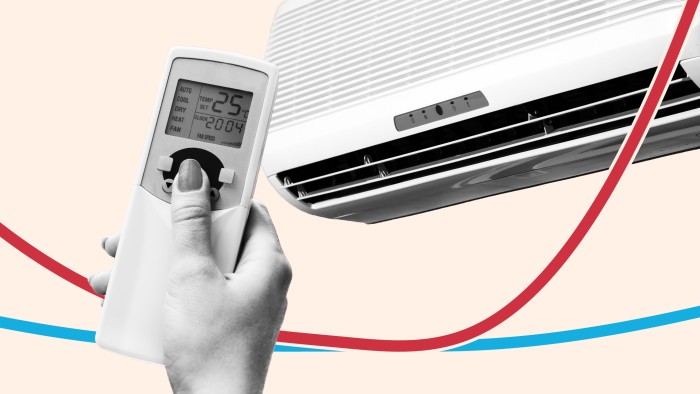Unlock the Editor’s Digest for free
Roula Khalaf, Editor of the FT, selects her favourite stories in this weekly newsletter.
When the late Singaporean premier Lee Kuan Yew was asked for the secret of his nation’s rapid rise from doldrums to dynamism during the second half of the 20th century, he had two answers. First: multi-ethnic tolerance in a diverse society. Second: air conditioning.
Lee, who prioritised the installation of air conditioners in government offices when he came to power in 1959, hailed the technology as “one of the signal inventions of history”, and key to increasing the efficiency of Singapore’s civil service.
While the precise contribution of air conditioning to the Singaporean miracle is hard to quantify, there is no question that the ability to keep cool in hot climates is enormously valuable.
Once indoor temperatures rise above the low-twenties centigrade, or around 75 Fahrenheit, humans start to suffer. Sleep duration and quality fall rapidly when temperatures rise above 23C. Cognitive performance fares similarly, with scores in US high school tests dipping on hot days, and the affected students suffering a lasting impact on their prospects of graduation. The same is true of office workers’ productivity, which peaks at around 21C and rapidly deteriorates as the mercury rises. And that’s all before we get on to mortality, where death rates climb steeply once temperatures hit 30C.
The key word here is indoor. All of these bleak outcomes can be avoided if the interiors of homes, schools and offices can be kept at a comfortable temperature even as the sun beats down outside. And while careful building design, passive cooling and other adaptations can offer some protection, once temperatures get high enough, only air conditioning can make a real difference.
As a result, with heatwaves rapidly increasing in frequency around the world, the wide US-Europe disparity in air conditioning use is becoming reflected in a startlingly wide disparity in heat-related deaths. Between 2000 and 2019, an average of 83,000 western Europeans lost their lives every year as a result of extreme heat, compared with 20,000 North Americans.

Yet despite the rising human toll, air conditioning remains widely frowned upon in the UK and Europe, with consistent and concerted pushback from those who consider the technology an unnecessary extravagance — and one that does more harm than good.
I have some sympathy with this, at least superficially. Air conditioning uses a lot of energy; if the proposed solution to emissions-driven global warming is to emit more, then we have an obvious problem.
But two key parts of the calculus here are changing rapidly. The first is the extent to which air conditioning is necessary. European cities are enduring more intense heat, more frequently and for longer periods than just a decade or two ago. Hot nights — where the risks to health are highest, and air conditioning adds the most value — are rising fastest of all. This year London is experiencing as much heat as Portland, Oregon, (18 days and counting of temperatures requiring active cooling), but without Portland’s cooling infrastructure (79 per cent of households there have air conditioning). The results will not be pretty.
And the second shift is that rising demand for air conditioning now aligns with rapidly rising supply of solar energy. The overwhelming majority of increased energy demand in the coming years will be supplied by clean sources — and that supply will also be most abundant when it is most needed for cooling. Moreover, the potential for air-to-air heat pumps to take care of all of a building’s temperature needs without burning gas (these are models that can both cool and heat) means the net impact on emissions could be negative.
Far from encouraging this, regulations in countries including the UK and France continue to disincentivise and even restrict these technologies. Meanwhile, others argue against their adoption on the basis that it will widen health and other inequalities.
The reverse is true. Unless authorities begin to treat the need for sufficient cooling as seriously as the need for adequate heating, and fulfil their duty to protect the most vulnerable, inequalities will widen as high-income households fork out for their own protection and leave the rest sweating.
Not too long ago there were sound arguments against Europe adopting air conditioning en masse, but the climate has changed.
[email protected], @jburnmurdoch
Data sources and methodology
Comparison of the temperature-mortality curve in European and US cities:
Temperature-mortality curves were adapted from Chen et al (2024). City pairings were chosen based on the number of days per year in each location with a maximum temperature at or above 28C/82F, at which point it is generally no longer possible to maintain comfortable conditions without using air conditioning.
Academic papers used in charts:
• Nighttime Ambient Temperature and Sleep in Community-Dwelling Older Adults (Baniassadi et al, 2024)
• Heat and Learning (Goodman et al, 2018)
• Room Temperature and Productivity in Office Work (Seppanen et al, 2006)
• Impact of population aging on future temperature-related mortality at different global warming levels (Chen et al, 2024)
